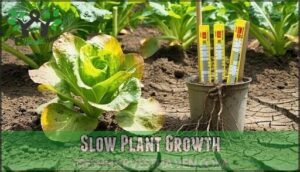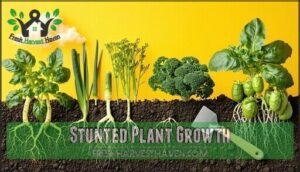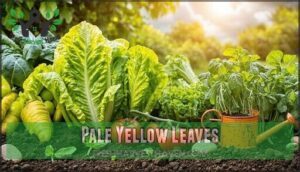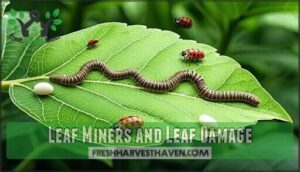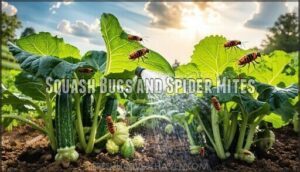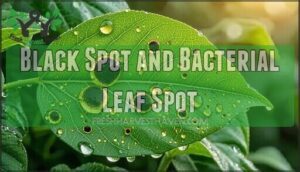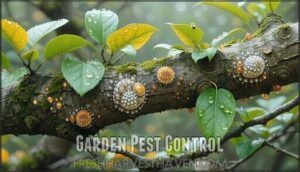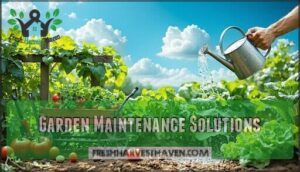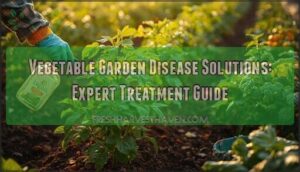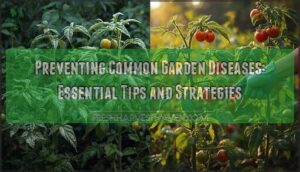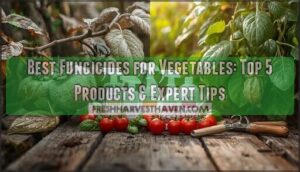This site is supported by our readers. We may earn a commission, at no cost to you, if you purchase through links.
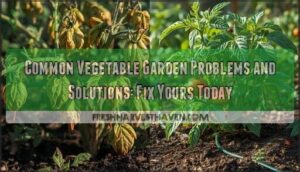 Your vegetable garden’s yellowing leaves, stunted growth, and pest problems stem from fixable issues like poor soil conditions, watering mistakes, or nutrient deficiencies.
Your vegetable garden’s yellowing leaves, stunted growth, and pest problems stem from fixable issues like poor soil conditions, watering mistakes, or nutrient deficiencies.
Most common vegetable garden problems and solutions involve adjusting your watering schedule, improving soil drainage, rotating crops, and identifying pest patterns early.
Simple fixes like checking soil temperature, using organic fertilizers, and selecting disease-resistant varieties can transform struggling plants into productive ones.
The key lies in understanding what your plants are telling you through their symptoms and responding with targeted solutions that address root causes rather than just surface issues, which is crucial for maintaining a healthy garden and requires a good understanding of soil temperature, organic fertilizers, and pest patterns to make informed decisions and apply the right fixes.
Table Of Contents
- Key Takeaways
- Seedling Germination Issues
- Plant Growth Problems
- Leaf and Stem Problems
- Garden Pest Control
- Garden Maintenance Solutions
- Frequently Asked Questions (FAQs)
- What is the best natural pest control for vegetable gardens?
- What are 5 things you should do to prepare a good veggie garden?
- Why is my garden growing but not producing?
- What’s the best fertilizer for a vegetable garden?
- What are the most difficult vegetables to grow?
- What is the most common mistake of first time gardeners?
- What is the best pest control for vegetable gardens?
- What’s wrong with my vegetable garden?
- Should you water your vegetable garden every day?
- What are three factors that should be considered when planning a vegetable garden?
- Conclusion
Key Takeaways
- Test your soil conditions first – You’ll solve most problems by checking soil pH (aim for 6.0-7.0), temperature (65-75°F for germination), and drainage before assuming you’ve got pest or disease issues.
- Water deeply but less frequently – You’ll prevent root rot and fungal diseases by watering every 2-3 days instead of daily, allowing soil to dry slightly between sessions while encouraging strong root development.
- Choose disease-resistant varieties and rotate crops – You’ll cut your pest problems in half by selecting resistant plant varieties and switching plant families every 3-4 years to break disease cycles naturally.
- Address symptoms early with targeted solutions – You’ll save your harvest by identifying specific problems (yellowing leaves = nutrient deficiency, holes = pest damage) and applying focused treatments rather than guessing at generic fixes.
Seedling Germination Issues
You’re probably staring at empty seed trays wondering why nothing’s sprouting after weeks of waiting. Seeds can be tricky, and several factors might be preventing germination in your vegetable garden.
Empty seed trays mock your patience while time ticks by with zero green sprouts to show for your effort.
Insufficient Time for Germination
Why won’t your seeds sprout when everything seems perfect? Sometimes they just need more time.
Seed viability varies by type—check expiration dates since germination rates drop substantially after 1-2 years. Some varieties have germination inhibitors that naturally delay sprouting. Try seed scarification or pre-soaking to break dormancy. Certain seeds require stratification—cold treatment before planting. Maintain consistent soil moisture and temperature for ideal seedling germination.
- Waiting weeks while neighbors’ gardens flourish
- Doubting your gardening skills over delayed sprouts
- Feeling frustrated when "quick-growing" seeds lag behind
- Worrying you’ve wasted money on bad seeds
- Second-guessing your germination timing decisions
Incorrect Soil Temperature
Cold soil creates a germination nightmare, causing seed rot and root damage before plants even start.
Soil temperature below 50°F triggers germination failure in most vegetables. Check soil problems with a thermometer—aim for 65-75°F for ideal soil health.
Use soil heating methods like black plastic or row covers to warm beds. Proper soil preparation prevents nutrient deficiencies and guarantees seeds sprout reliably when conditions improve.
Understanding soil pH levels is vital for maintaining healthy soil and preventing germination issues.
Dry Soil Conditions
Proper soil moisture management prevents seedling failure and drought stress. When watering issues arise, your garden suffers immediately.
Here’s how to fix dry conditions:
- Check soil moisture daily by inserting your finger two inches deep
- Apply mulch around plants to improve water retention and prevent soil erosion
- Water deeply but less frequently to encourage strong root development
- Install drip irrigation management systems for consistent moisture delivery
- Add organic matter to improve drought tolerance and soil problems
These watering techniques create ideal growing conditions for healthy seedlings.
Old or Non-Viable Seeds
When checking seed expiration dates reveals they’re past their prime, you’re facing a common germination roadblock.
Seed viability factors decline over time, making old seeds less reliable than fresh ones.
Perform germination testing by soaking a few seeds overnight—viable ones typically sink.
Store remaining seeds in cool, dry conditions for better seed storage longevity, but consider replanting options with fresh stock when seeds not sprouting becomes problematic.
Bird or Insect Damage
Unfortunately wildlife can wreck your newly planted seeds before they sprout. Birds love fresh seeds, while cutworms and root maggots attack vulnerable seedlings underground.
Nature doesn’t wait for perfect timing—hungry wildlife strikes the moment you plant.
Here’s your protection plan:
- Cover vulnerable areas with row covers or fine mesh netting
- Install reflective tape or aluminum pie pans to deter birds
- Apply beneficial nematodes to soil for cutworm control
- Create protective collars around individual seedlings using cardboard tubes
Smart pest management starts early – identifying garden damage from insect pests versus bird damage helps you choose effective pest control methods for lasting crop protection.
Plant Growth Problems
Nothing frustrates gardeners more than watching their vegetable plants struggle to thrive despite their best efforts.
Whether you’re dealing with weak seedlings, stunted growth, or yellowing leaves, these common plant growth problems usually have straightforward solutions once you identify the root cause.
These problems can be addressed by understanding the underlying issues, and with the right approach, gardeners can help their plants thrive.
Weak and Spindly Plants
Weak plants signal something’s wrong with their growing conditions. Insufficient sunlight causes spindly stems as plants stretch toward light.
You’ll need six hours of direct sun daily for strong plant growth. Overwatering creates root damage and weak stems through fungal issues.
Poor soil quality leads to nutrient deficiency, producing pale, fragile plants. Test your soil and add compost to improve plant care fundamentals.
To address low light conditions, consider using indoor grow lights to supplement natural light.
Slow Plant Growth
Your plants feel stuck in slow motion? Here’s what’s holding them back:
- Light Intensity problems – Most vegetables need 6-8 hours of direct sunlight daily
- Nutrient Deficiency issues – Pale yellow leaves often signal nitrogen shortage
- Root Bound containers – Cramped roots can’t access water and nutrients properly
Check your Soil pH too – imbalanced levels prevent nutrient uptake, creating Water Stress and Weak Plants even with proper care.
Stunted Plant Growth
Stunted growth stops your plants dead in their tracks, robbing you of the harvest you’re counting on.
When roots can’t breathe through compacted soil or nutrients run thin, your vegetables hit an invisible ceiling.
Watch for these telltale signs:
- Root Bound containers: Roots circle the pot bottom, creating water stress and nutrient deficiency
- Soil Compaction: Hard-packed earth blocks oxygen flow and root expansion
- Nutrient Deficiency: Missing nitrogen, phosphorus, or potassium shows as slow growth and leaf discoloration
- pH Imbalance: Wrong soil acidity prevents nutrient uptake, causing root problems
Understanding common garden issues is essential to addressing stunted plant growth effectively.
Pale Yellow Leaves
Yellow leaves in your garden aren’t just an eyesore—they’re your plants crying for help. Chlorosis signals nutrient deficiency, particularly nitrogen, iron, or magnesium shortages that prevent proper chlorophyll production.
Before panicking about plant diseases, check your soil pH. When it’s too acidic or alkaline, roots can’t absorb nutrients effectively, causing leaf discoloration and nutrient imbalance. Most vegetables thrive in slightly acidic to neutral soil (6.0-7.0 pH).
Fertilizer imbalance compounds these issues. Too much of one nutrient blocks others, while leaf scorch from over-fertilizing mimics deficiency symptoms. Understanding chlorosis causes helps you target solutions rather than guessing at remedies.
Leaf and Stem Problems
When leaves show spots, holes, or unusual growths, you’re dealing with common but manageable problems that can quickly spread if left untreated.
These leaf and stem issues range from sneaky pests mining through your greens to fungal diseases that thrive in humid conditions.
Leaf Miners and Leaf Damage
You’ll spot leaf miners by their telltale squiggly trails carved through your leaf damage. These foliar pests create winding tunnels that turn brown, weakening your plants’ ability to photosynthesize.
Check young seedlings regularly for pest identification – catching miner infestation early makes all the difference. Remove affected leaves immediately to prevent spread.
For leaf miner control, apply spinosad to stop adults from laying eggs, though it won’t eliminate existing larvae. Garden pest control works best when combined with encouraging beneficial predators and avoiding broad-spectrum insecticides that harm helpful insects.
Downy Mildew and Powdery Mildew
After dealing with leaf miners, fungal diseases like downy and powdery mildew create another challenge in your vegetable garden problems.
These mildew types show distinct symptoms—downy appears as yellow spots with gray fuzz underneath leaves, while powdery looks like white dust on surfaces.
Fungicide use and disease prevention through proper spacing help control outbreaks.
Soil treatment and avoiding overhead watering reduce humidity that fuels these infections.
Squash Bugs and Spider Mites
Two persistent garden pests require different squash bug control and spider mite prevention strategies.
Squash bugs drain plant nutrients, causing yellow lesions and wilting, while spider mites create stippled leaves with telltale webbing.
Use row cover methods early in the season, apply organic insecticides like neem oil for squash bugs, and spray water regularly to dislodge spider mites and prevent insect infestations.
Understanding effective control methods is essential for managing these pests successfully.
Black Spot and Bacterial Leaf Spot
While pests can damage your garden’s leaves and stems, fungal diseases and bacterial spot create their own unique challenges.
Black spot and bacterial leaf spot appear as dark, circular marks that weaken plants and reduce yields.
Here’s how to identify and treat these common plant diseases and pests:
- Black spot thrives in humid conditions with poor air circulation
- Bacterial spot spreads rapidly in warm, wet weather conditions
- Leaf blight symptoms include yellowing around dark spots
Disease prevention starts with proper plant spacing and avoiding overhead watering.
Apply copper fungicide use treatments early, and select resistant varieties when possible.
Garden Pest Control
Garden pests can quickly destroy your hard work, turning healthy plants into damaged crops within days.
You’ll need to identify common invaders like aphids, flea beetles, and hornworms early, then choose the right control method to protect your harvest.
Common Vegetable Garden Pests
Vegetable garden pests can quickly turn your thriving crops into damaged disappointments.
Identifying these troublemakers early makes all the difference in protecting your harvest. Aphids cluster on tender shoots, sucking plant juices and weakening growth. Flea beetles create tiny holes in leaves, especially targeting brassicas like cabbage and broccoli. Hornworms devour tomato plants overnight, leaving behind stripped stems.
- Your morning garden check reveals new damage that wasn’t there yesterday
- Healthy plants suddenly show mysterious holes and wilting symptoms
- Beneficial insects disappear while destructive pests multiply rapidly
Organic Pest Control Methods
Smart organic pest control methods protect your garden naturally. Natural Predators like ladybugs reduce aphid populations by 90% within weeks.
Pest Traps and Crop Covers create physical barriers against harmful insects.
| Method | Effectiveness |
|---|---|
| Insecticidal Soap | 80% mortality in soft-bodied pests |
| Biological Controls | 50% reduction in cutworm populations |
| Organic Fungicides | Controls black spot and mildew |
| Natural Remedies | 60% decrease in spider mite density |
These organic pesticides work without harsh chemicals, keeping your vegetables safe while maintaining effective pest control. Effective organic pest solutions are essential for a healthy garden ecosystem.
Chemical Pest Control Options
When standard organic methods aren’t cutting it, chemical pest control provides powerful backup options.
Systemic insecticides like imidacloprid work from within plants for long-lasting protection.
Broad-spectrum chemical sprays tackle multiple pests simultaneously, while targeted pesticides focus on specific problems.
Insecticidal soap offers gentler chemical intervention, and fungicides handle disease issues.
Always rotate products to prevent resistance and follow label directions precisely for safe, effective pest management.
Preventing Pest Infestations
Proactive pest management starts with creating barriers that prevent infestations before they begin.
Smart gardeners use these proven prevention strategies:
- Install pest traps and insect barriers like row covers to block flying pests from reaching vulnerable crops.
- Practice soil sanitation by removing plant debris and rotating crops annually to disrupt pest life cycles.
- Apply organic pesticides preventively during peak egg-laying seasons to reduce future generations.
Garden Maintenance Solutions
Prevention beats fixing problems after they start, and smart garden maintenance keeps your vegetables thriving all season long.
You’ll save time and frustration by establishing proper watering schedules, rotating crops, maintaining soil health, and choosing disease-resistant varieties.
Proper Watering Techniques
Proper watering starts with checking soil moisture first—stick your finger two inches deep before watering.
Overwatering causes more problems than underwatering, leading to water logging and root rot.
Drip irrigation delivers water directly to roots, preventing waste. Install drainage systems if water pools after rain.
Water deeply but less frequently to encourage strong root development and prevent drought stress. Understanding summer garden watering techniques is essential for maintaining a healthy garden.
Crop Rotation and Sanitation
Crop rotation transforms your garden into a healthier ecosystem by switching plant families every three to four years.
This rotation scheme breaks pest and disease cycles while improving soil improvement naturally.
Garden sanitation complements rotation—remove infected plant debris, clean tools between uses, and maintain proper garden cleanup practices.
Together, these sanitation methods create effective pest and disease management, preventing problems before they start.
Smart crop planning and thorough soil preparation maximize these benefits for long-term garden success.
Soil Health and Fertility
Beyond maintaining clean growing spaces, your soil’s foundation determines your garden’s success.
Soil pH between 6.0-7.0 facilitates nutrient availability, while acidic conditions create nutrient deficiencies that stunt growth.
Organic matter acts like a sponge, improving water retention and feeding beneficial microbes that break down nutrients for plant uptake.
Compost benefits extend beyond nutrition—it prevents fertilizer burn by releasing nutrients slowly.
Smart soil improvement strategies include:
- Testing soil pH every two years for ideal plant nutrition
- Adding 2-4 inches of compost annually to boost organic matter
- Using balanced fertilizers to prevent nutrient imbalances
- Incorporating cover crops between seasons for natural soil nutrition
- Avoiding over-fertilization that leads to salt buildup and fertilizer burn
Regular soil testing with a soil test kit helps monitor nutrient levels and pH.
Disease-Resistant Varieties and Pruning
Smart gardeners know that resistant crops act like natural bodyguards against vegetable diseases.
Choose disease-resistant varieties and combine them with strategic pruning tips for maximum disease prevention.
Remove infected leaves regularly to improve airflow and reduce plant disease symptoms.
This powerful combination cuts fungicide use while boosting yields through better garden hygiene practices.
Frequently Asked Questions (FAQs)
What is the best natural pest control for vegetable gardens?
Attract beneficial insects, use companion planting, and apply organic sprays like neem oil.
Row covers protect crops while predators like ladybugs and parasitic wasps naturally control aphids and other harmful pests effectively, using methods like companion planting.
What are 5 things you should do to prepare a good veggie garden?
Test your soil’s pH and nutrient levels, then add organic compost.
Choose a sunny location with good drainage.
Plan your garden layout considering plant spacing and companion planting.
Select disease-resistant varieties suited to your climate zone.
Why is my garden growing but not producing?
Your thriving garden’s playing hard to get—lush leaves but no harvest?
You’re likely overfeeding with nitrogen, creating leafy showoffs that skip fruiting.
Switch to balanced fertilizers like 4-12-4, make certain adequate sunlight, and check for pollination issues.
What’s the best fertilizer for a vegetable garden?
Use balanced fertilizers like 10-10-10 or organic compost to avoid excessive nitrogen that creates leafy growth without fruit production.
Test your soil’s pH and nutrient levels first for targeted feeding, ensuring a complete approach to fertilization.
What are the most difficult vegetables to grow?
Only 13% of vegetable garden problems stem from combined rots, yet tomatoes and eggplants remain the trickiest crops you’ll face.
They’re vulnerable to blight, hornworms, and temperature swings that’ll test your gardening patience daily.
What is the most common mistake of first time gardeners?
Most first-time gardeners overwater their plants, thinking they’re being helpful.
You’ll kill more vegetables with too much love than too little—soggy roots can’t breathe and quickly develop fatal fungal diseases.
What is the best pest control for vegetable gardens?
Prevention is your best defense—use row covers to block flea beetles, plant disease-resistant varieties, and attract beneficial insects with flowering herbs. For active infestations, apply spinosad or insecticidal soap.
What’s wrong with my vegetable garden?
Several factors could be causing your garden troubles.
Check for pests like aphids, flea beetles, or hornworms on leaves.
Examine soil moisture—both overwatering and underwatering cause wilting.
Test soil pH and nutrients, make certain proper spacing for airflow, and inspect for disease symptoms like yellowing or spotted leaves.
Should you water your vegetable garden every day?
You shouldn’t water your vegetable garden daily.
Most plants need deep, infrequent watering—typically every 2-3 days depending on weather, soil type, and plant maturity.
Daily watering can lead to shallow roots and fungal diseases.
What are three factors that should be considered when planning a vegetable garden?
You’ll need to take into account sunlight exposure, soil quality, and available space.
Choose locations with 6-8 hours of direct sunlight, test your soil’s pH and drainage, and plan spacing that allows proper air circulation between plants.
Conclusion
Sarah’s tomato plants developed brown spots and wilted overnight, but after testing her soil pH and adjusting her watering schedule, they bounced back within two weeks.
You’ll face similar challenges, but don’t panic. These common vegetable garden problems and solutions become manageable once you identify the root causes.
Check your soil temperature, adjust watering frequency, and choose disease-resistant varieties.
With proper diagnosis and targeted fixes, you’ll transform struggling plants into thriving ones that produce abundant harvests throughout the growing season.


